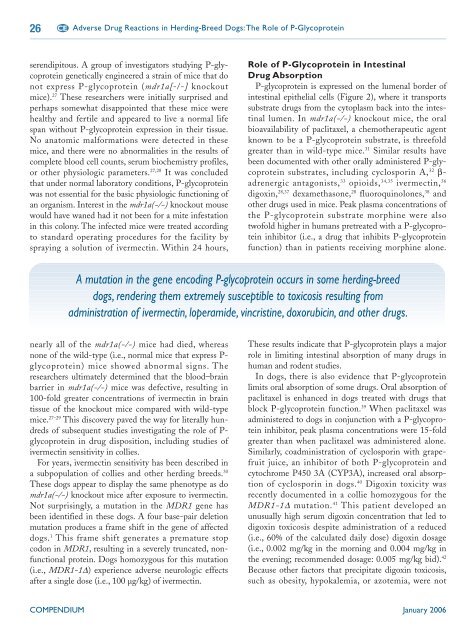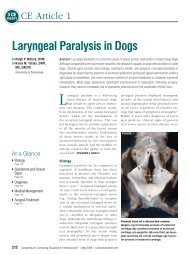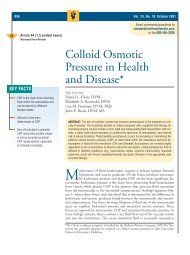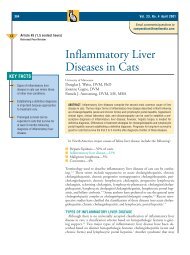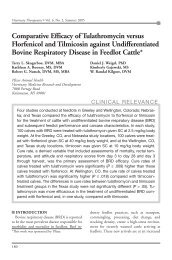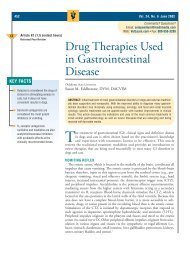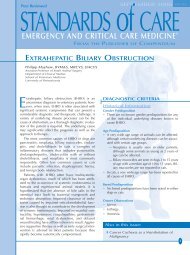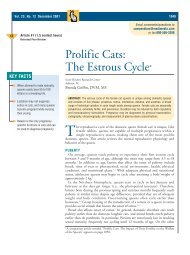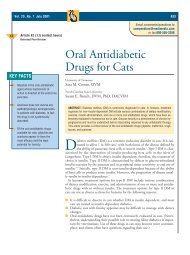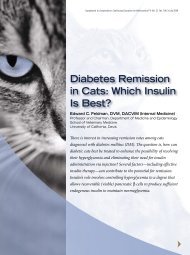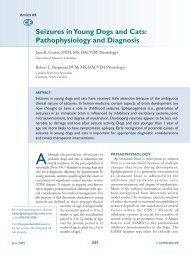The Role of P-Glycoprotein - VetLearn.com
The Role of P-Glycoprotein - VetLearn.com
The Role of P-Glycoprotein - VetLearn.com
- TAGS
- cp.vetlearn.com
You also want an ePaper? Increase the reach of your titles
YUMPU automatically turns print PDFs into web optimized ePapers that Google loves.
26 CE<br />
Adverse Drug Reactions in Herding-Breed Dogs:<strong>The</strong> <strong>Role</strong> <strong>of</strong> P-<strong>Glycoprotein</strong><br />
serendipitous. A group <strong>of</strong> investigators studying P-glycoprotein<br />
genetically engineered a strain <strong>of</strong> mice that do<br />
not express P-glycoprotein (mdr1a[-/-] knockout<br />
mice). 27 <strong>The</strong>se researchers were initially surprised and<br />
perhaps somewhat disappointed that these mice were<br />
healthy and fertile and appeared to live a normal life<br />
span without P-glycoprotein expression in their tissue.<br />
No anatomic malformations were detected in these<br />
mice, and there were no abnormalities in the results <strong>of</strong><br />
<strong>com</strong>plete blood cell counts, serum biochemistry pr<strong>of</strong>iles,<br />
or other physiologic parameters. 27,28 It was concluded<br />
that under normal laboratory conditions, P-glycoprotein<br />
was not essential for the basic physiologic functioning <strong>of</strong><br />
an organism. Interest in the mdr1a(-/-) knockout mouse<br />
would have waned had it not been for a mite infestation<br />
in this colony. <strong>The</strong> infected mice were treated according<br />
to standard operating procedures for the facility by<br />
spraying a solution <strong>of</strong> ivermectin. Within 24 hours,<br />
nearly all <strong>of</strong> the mdr1a(-/-) mice had died, whereas<br />
none <strong>of</strong> the wild-type (i.e., normal mice that express Pglycoprotein)<br />
mice showed abnormal signs. <strong>The</strong><br />
researchers ultimately determined that the blood–brain<br />
barrier in mdr1a(-/-) mice was defective, resulting in<br />
100-fold greater concentrations <strong>of</strong> ivermectin in brain<br />
tissue <strong>of</strong> the knockout mice <strong>com</strong>pared with wild-type<br />
mice. 27–29 This discovery paved the way for literally hundreds<br />
<strong>of</strong> subsequent studies investigating the role <strong>of</strong> Pglycoprotein<br />
in drug disposition, including studies <strong>of</strong><br />
ivermectin sensitivity in collies.<br />
For years, ivermectin sensitivity has been described in<br />
a subpopulation <strong>of</strong> collies and other herding breeds. 30<br />
<strong>The</strong>se dogs appear to display the same phenotype as do<br />
mdr1a(-/-) knockout mice after exposure to ivermectin.<br />
Not surprisingly, a mutation in the MDR1 gene has<br />
been identified in these dogs. A four base-pair deletion<br />
mutation produces a frame shift in the gene <strong>of</strong> affected<br />
dogs. 1 This frame shift generates a premature stop<br />
codon in MDR1, resulting in a severely truncated, nonfunctional<br />
protein. Dogs homozygous for this mutation<br />
(i.e., MDR1-1∆) experience adverse neurologic effects<br />
after a single dose (i.e., 100 µg/kg) <strong>of</strong> ivermectin.<br />
<strong>Role</strong> <strong>of</strong> P-<strong>Glycoprotein</strong> in Intestinal<br />
Drug Absorption<br />
P-glycoprotein is expressed on the lumenal border <strong>of</strong><br />
intestinal epithelial cells (Figure 2), where it transports<br />
substrate drugs from the cytoplasm back into the intestinal<br />
lumen. In mdr1a(-/-) knockout mice, the oral<br />
bioavailability <strong>of</strong> paclitaxel, a chemotherapeutic agent<br />
known to be a P-glycoprotein substrate, is threefold<br />
greater than in wild-type mice. 31 Similar results have<br />
been documented with other orally administered P-glycoprotein<br />
substrates, including cyclosporin A, 32 βadrenergic<br />
antagonists, 33 opioids, 34,35 ivermectin, 36<br />
digoxin, 28,37 dexamethasone, 28 fluoroquinolones, 38 and<br />
other drugs used in mice. Peak plasma concentrations <strong>of</strong><br />
the P-glycoprotein substrate morphine were also<br />
tw<strong>of</strong>old higher in humans pretreated with a P-glycoprotein<br />
inhibitor (i.e., a drug that inhibits P-glycoprotein<br />
function) than in patients receiving morphine alone.<br />
A mutation in the gene encoding P-glycoprotein occurs in some herding-breed<br />
dogs, rendering them extremely susceptible to toxicosis resulting from<br />
administration <strong>of</strong> ivermectin, loperamide, vincristine, doxorubicin, and other drugs.<br />
<strong>The</strong>se results indicate that P-glycoprotein plays a major<br />
role in limiting intestinal absorption <strong>of</strong> many drugs in<br />
human and rodent studies.<br />
In dogs, there is also evidence that P-glycoprotein<br />
limits oral absorption <strong>of</strong> some drugs. Oral absorption <strong>of</strong><br />
paclitaxel is enhanced in dogs treated with drugs that<br />
block P-glycoprotein function. 39 When paclitaxel was<br />
administered to dogs in conjunction with a P-glycoprotein<br />
inhibitor, peak plasma concentrations were 15-fold<br />
greater than when paclitaxel was administered alone.<br />
Similarly, coadministration <strong>of</strong> cyclosporin with grapefruit<br />
juice, an inhibitor <strong>of</strong> both P-glycoprotein and<br />
cytochrome P450 3A (CYP3A), increased oral absorption<br />
<strong>of</strong> cyclosporin in dogs. 40 Digoxin toxicity was<br />
recently documented in a collie homozygous for the<br />
MDR1-1∆ mutation. 41 This patient developed an<br />
unusually high serum digoxin concentration that led to<br />
digoxin toxicosis despite administration <strong>of</strong> a reduced<br />
(i.e., 60% <strong>of</strong> the calculated daily dose) digoxin dosage<br />
(i.e., 0.002 mg/kg in the morning and 0.004 mg/kg in<br />
the evening; re<strong>com</strong>mended dosage: 0.005 mg/kg bid). 42<br />
Because other factors that precipitate digoxin toxicosis,<br />
such as obesity, hypokalemia, or azotemia, were not<br />
COMPENDIUM January 2006


